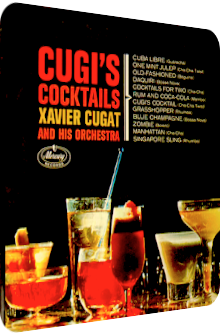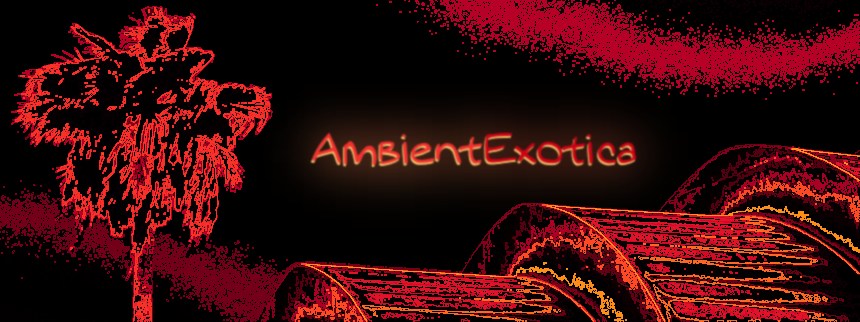
Xavier Cugat
Cugi's Cocktails
1963
A eupeptic weekend in lushly furnished homes with technicolored carpets, hairspray-heavy haircuts, sweet mint tobacco scent and one too many drinks. That's the spirit of the 60's, perfectly entrapped in Afro-Cuban Jazz king Xavier Cugat (1900–1990). On this predominantly Latin and Cuban Jazz record, Cugat comes up with 12 mostly unique compositions, each of them named after a different cocktail and presented in a different music style. Merengues, Bossa Novas and Boleros are scattered all over the record, and the big band brings each and every skit to live in an upbeat fashion. Their way of playing ranges from silky horn sections over the typical Cha-Cha staccato to enormous brass eruptions that outshine each and every element. The different flavors of the horns are equally attractive.
Some conductors of Latin tracks use these instruments in a boring, obvious way, but not Cugat, who presents a mélange of great diversity. This is a cocktail album par excellence, and the Space-Age theme is strongly interwoven despite the Latin flavor. Even the front artwork doesn't make any secrets about the sole point of the album: play it while your house is full of guests, and entertainment ensues. While the drinking and smoking culture is seen as way more critical today, even social smokers and non-drinkers (or vice versa) will find the compositions refreshingly vivid. It's one of the very best Latin Space-Age albums out there that should be consumed often.
Cuba Libre, a recipe by co-barkeepers Cugat and Ira Asherman is served first. Vividly interacting brass sections, quickly played mellow marimba droplets, frantic piano chords and silky paradisiac flutes make this Gurarcha an excellent entry. Best of all is the broad pool of instruments. This song doesn't feature the typical hot-blooded Latin keys but presents itself in a world-embracing style, with many of the above mentioned ingredients borrowed from the Polynesian realms of Exotica. It's a swinging track but without too bold or overly loud brass intersections. A top pick right at the beginning!
One Mint Julep ventures into show tune territories. Mixing Cha-Cha with the Twist genre, this convivial, slower track is loaded with staccato brass sections and mellow eruptions every so often that shimmer and gleam in golden colors. An electric organ à la Cal Tjader is embedded, and its improvised quirkiness fits very well with both the good mood this track evokes and the brass-heavy surroundings. The drums are on the foreground as well, bolstering the energetic atmosphere further. Up next, however, is a Latin track by the numbers that is fittingly called Old-Fashioned, composed by Antonio Campoy Guijarro and José Sanchez Sola. The majestic lamento of the trumpet causes an equally pompous reaction by the brass ensemble. This sunset-evoking solo trumpet remains the only boldly Latin ingredient, as the remaining instruments consist of beautiful flute melodies, melodramatic piano sprinkles, marimba cascades and acoustic guitar backings. This superstructure is exceeded by the solemnity of the torero-like standoff melody realized with the brass sections. Another clear winner and not that old-fashioned thanks to its exotic curlicues.
And so the binge drinking continues. The Bossa Nova-esque Daiquiri by Luiz Antônio and Djalma Ferreira is filled with a tremendously spacey, almost spectral organ, spiraling marimbas and a lamenting main melody on the trumpet that is deliciously framed by acoustic guitar twangs and Brazilian percussion. The signature element remains that particular organ, though. Space-Age alert! While Cocktails For Two is a gorgeous shaker-laden Cha-Cha skit with interchanging choppy sections and their romantically melting brethren, Rum And Coca-Cola by the trio Paul Baron, Morey Amsterdam and Jeri Sullivan is a lively Mambo with car horn-like background fragments, laid back piano backings and easy-going alto flute layers. The exotic percussion can be considered the main attraction here, with lots of cowbells, shakers and bongos more prominently in the foreground than before.
The title-lending Cugi's Cocktail is a letdown in terms of its creator, for the big Hal Mooney came up with the composition, not Cugat himself. These minor quibbles aside, this piano-fueled Latin speciality still cannot impress me. Its chords are warm and mellow, but too blurry and indifferent. The acidic brass stabs are much better, but though there's enough fire behind them, the melodies are rather weak in comparison to the tasty material that has been delivered thus far. I usually avoid ordering this cocktail.
Hugo Blanco's Grasshopper Rhumba caters to my taste. It's the obvious cheeky track on the album, with another great use of the car horn-like organ that is as silky as it is melodious. The brass sections aren't too punchy but get along well with the overall silkiness and streamlined presentation. The spiraling marimbas are worth mentioning as well, for they whirl almost manically. Yep, this track offers a maximum of saccharine sirup, but it's oh so tasty and good-natured. I can fully understand if this is considered the weakest track by fans of Latin music, but I really like it very much, since it's the only track of this style. 12 tracks like Grasshopper in a row would definitely be nerve-racking for me, but one glass of it doesn't hurt.
A Blue Champagne is very welcome as well. Car horn-like, Walter Wenderley-esque organ bits are once again the selling point of this mixture. The horns oscillate between romance and showtime, and the vibraphone is a nice inclusion as well, its notes resembling the sparkling bubbles of the champagne. Now to the Zombie. Co-written by John Latouche and Xavier Cugat, it starts with a sizzling-hot afternoon organ and moves into exotic territories by featuring an alto flute melody, Polynesian percussion, guitar backings and the almost mandatory marimba. Even though the track is surprisingly keen on slightly melancholic keys, the atmosphere remains sun-soaked and bright.
The following Manhattan intertwines electric piano flashes with Cha-Cha marimba bits and staccato melodies played on the various horns. The phantasmagoric flute takes away the last bit of spiciness of this track, and it is up to the final Singapore Sling to augment the stylistic variety of the album at the end, laying a twelve-note Latin spy theme over a sneaky electric organ while the chorus is entirely blithesome. The organ seems to have bathed in light as its chords seem to be warm and vibrant. The album ends on a vibraphone note, an instrument whose use is surprisingly reduced on this release – an incessant similarity to Cal Tjader's tunes would've been too great, I suppose.
Cugi's Cocktails is an assorted selection of Space-Age material. The clear presence of organs and electric pianos is a splendid addition to the omnipresent brass ensemble. The horns aren't played in Latin style at all, and while there are clichéd instances where a melodramatic feeling is evoked with their help, Cugat's presentation is surprisingly innovative and relies less on the typical Latin keys and chords rather than on proper exotic ingredients. Flutes, marimbas and exotic percussion all help to rightfully categorize this album as a proper Exotica cut. With the exception of the title song Cugi's Cocktails, all of the eleven remaining drinks are delicious and varied. I can recommend this album to every Exotica fan, but especially to those listeners who are more than a bit wary of Latin clichés, for these are traversing the songs only occasionally, for example in the song Old-Fashioned. Even though all of the twelve tracks present particularly Latin styles and genres, the Space-Age and Exotica factor is always larger and more important. Give it a spin or get it from iTunes, Amazon and co.
Exotica Review 088: Xavier Cugat – Cugi's Cocktails (1963). Originally published on Jun. 30, 2012 at AmbientExotica.com.
